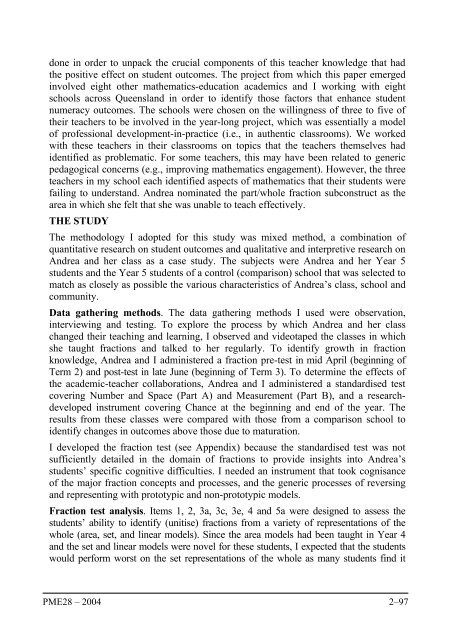empowering andrea to help year 5 students construct fraction ...
empowering andrea to help year 5 students construct fraction ...
empowering andrea to help year 5 students construct fraction ...
Create successful ePaper yourself
Turn your PDF publications into a flip-book with our unique Google optimized e-Paper software.
done in order <strong>to</strong> unpack the crucial components of this teacher knowledge that had<br />
the positive effect on student outcomes. The project from which this paper emerged<br />
involved eight other mathematics-education academics and I working with eight<br />
schools across Queensland in order <strong>to</strong> identify those fac<strong>to</strong>rs that enhance student<br />
numeracy outcomes. The schools were chosen on the willingness of three <strong>to</strong> five of<br />
their teachers <strong>to</strong> be involved in the <strong>year</strong>-long project, which was essentially a model<br />
of professional development-in-practice (i.e., in authentic classrooms). We worked<br />
with these teachers in their classrooms on <strong>to</strong>pics that the teachers themselves had<br />
identified as problematic. For some teachers, this may have been related <strong>to</strong> generic<br />
pedagogical concerns (e.g., improving mathematics engagement). However, the three<br />
teachers in my school each identified aspects of mathematics that their <strong>students</strong> were<br />
failing <strong>to</strong> understand. Andrea nominated the part/whole <strong>fraction</strong> sub<strong>construct</strong> as the<br />
area in which she felt that she was unable <strong>to</strong> teach effectively.<br />
THE STUDY<br />
The methodology I adopted for this study was mixed method, a combination of<br />
quantitative research on student outcomes and qualitative and interpretive research on<br />
Andrea and her class as a case study. The subjects were Andrea and her Year 5<br />
<strong>students</strong> and the Year 5 <strong>students</strong> of a control (comparison) school that was selected <strong>to</strong><br />
match as closely as possible the various characteristics of Andrea’s class, school and<br />
community.<br />
Data gathering methods. The data gathering methods I used were observation,<br />
interviewing and testing. To explore the process by which Andrea and her class<br />
changed their teaching and learning, I observed and videotaped the classes in which<br />
she taught <strong>fraction</strong>s and talked <strong>to</strong> her regularly. To identify growth in <strong>fraction</strong><br />
knowledge, Andrea and I administered a <strong>fraction</strong> pre-test in mid April (beginning of<br />
Term 2) and post-test in late June (beginning of Term 3). To determine the effects of<br />
the academic-teacher collaborations, Andrea and I administered a standardised test<br />
covering Number and Space (Part A) and Measurement (Part B), and a researchdeveloped<br />
instrument covering Chance at the beginning and end of the <strong>year</strong>. The<br />
results from these classes were compared with those from a comparison school <strong>to</strong><br />
identify changes in outcomes above those due <strong>to</strong> maturation.<br />
I developed the <strong>fraction</strong> test (see Appendix) because the standardised test was not<br />
sufficiently detailed in the domain of <strong>fraction</strong>s <strong>to</strong> provide insights in<strong>to</strong> Andrea’s<br />
<strong>students</strong>’ specific cognitive difficulties. I needed an instrument that <strong>to</strong>ok cognisance<br />
of the major <strong>fraction</strong> concepts and processes, and the generic processes of reversing<br />
and representing with pro<strong>to</strong>typic and non-pro<strong>to</strong>typic models.<br />
Fraction test analysis. Items 1, 2, 3a, 3c, 3e, 4 and 5a were designed <strong>to</strong> assess the<br />
<strong>students</strong>’ ability <strong>to</strong> identify (unitise) <strong>fraction</strong>s from a variety of representations of the<br />
whole (area, set, and linear models). Since the area models had been taught in Year 4<br />
and the set and linear models were novel for these <strong>students</strong>, I expected that the <strong>students</strong><br />
would perform worst on the set representations of the whole as many <strong>students</strong> find it<br />
PME28 – 2004 2–97

















